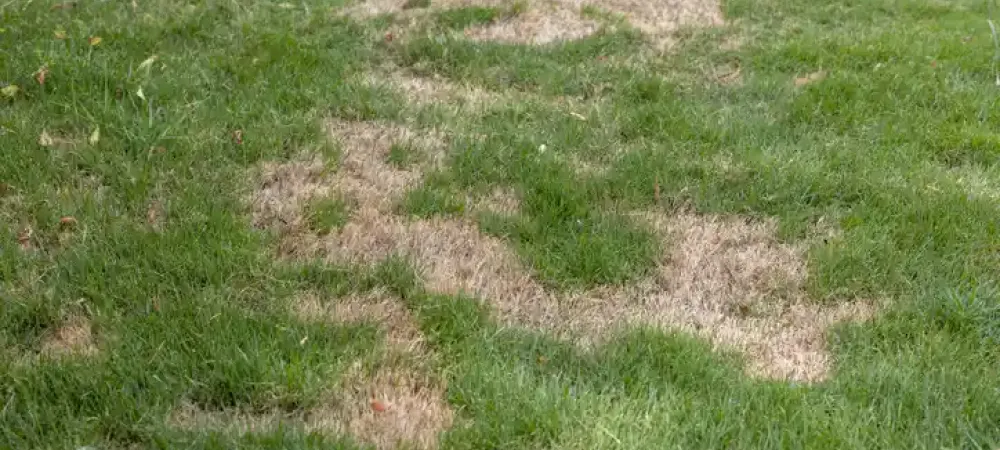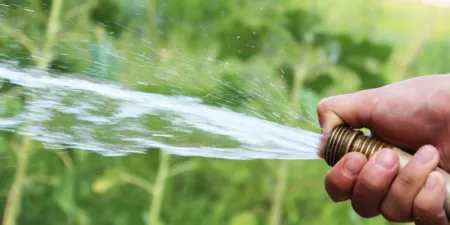How to Fix Dying or Thinning Lawn Spots Year-Round (Plus Overseeding Tips)

No one wants to see brown patches or bare spots creeping across the yard. Whether it’s a few dry areas or widespread lawn thinning, these issues don’t always fix themselves, and ignoring them can make the problem worse.
If you’re wondering how to fix dying grass or deal with brown spots, the right repair plan depends on understanding the cause and knowing what steps to take in each season. This guide breaks down the common reasons for lawn damage and shares how to bring your turf back to life—especially with strategic overseeding and year-round care.
Common Causes of Lawn Death & Thin Spots
Lawn thinning isn’t just about bad luck—it’s usually the result of a specific issue. Here are the most common causes:
- Drought or poor watering habits. Lawns need about 1 inch of water per week. Extended dry spells or shallow watering can cause turf to brown or go dormant.
- Pests like grubs or chinch bugs. These insects chew roots or sap moisture, especially during summer, and leave irregular bare areas behind.
- Fungal diseases. Brown patch, dollar spot, and other diseases love humidity. If patches appear overnight or spread quickly, fungus may be the cause.
- Soil compaction. When soil gets packed down from foot traffic or clay-heavy conditions, water and nutrients can’t reach the roots.
- Pet urine or stress damage. High-nitrogen dog urine or heavy play areas can burn grass or cause spotty damage.
- Poor mowing habits. Cutting too short or using dull blades can stress turf and weaken the grass over time.
Seasonal clues can help diagnose the issue. For example, if spots appear in the heat of summer, drought or pests may be to blame. If you see issues in spring or fall, fungal activity or soil problems may be the root cause.
Year-Round Lawn Spot Repair Strategy
The good news? No matter the season, there are steps you can take to revive dead or thinning areas in your yard. Here’s what a complete lawn repair plan looks like.
Test & Amend Soil

Start with a soil test to check pH levels and nutrient balance. If your soil is too acidic or lacking in key nutrients, your grass won’t grow properly—even with seeding.
- Use lime to raise pH or sulfur to lower it.
- Apply fertilizer if nitrogen, phosphorus, or potassium levels are low.
Remove Dead Grass & Dethatch
Clear out dead or matted grass using a rake or dethatching blade. Too much thatch (over ½ inch thick) can block water and nutrients from reaching the roots.
- Spring and early fall are the best times to dethatch your lawn.
- Removing buildup before seeding improves seed-to-soil contact.
Aerate Compacted Areas
If the soil is hard and difficult to penetrate, it’s time to aerate. Core aeration removes plugs of soil, while spike aeration pokes holes in the surface.
- Aeration improves drainage and root growth, which helps with lawn spot repair.
- For best results, aerate in spring or fall when your grass is actively growing.
- You can learn more about our aeration and overseeding services here.
Pick the Right Grass Seed
Not all grass seed is the same. Choosing the right type ensures your new grass blends with the existing lawn and thrives in your region.
- Use warm-season grasses (like Bermuda or Zoysia) in southern climates.
- Cool-season grasses (like Fescue) are best for transitional zones or shady areas.
- When in doubt, choose blends labeled for overseeding or your region’s climate.
Overseed Strategically
Overseeding lawn repair involves spreading new seed over your current grass to thicken thin spots or fill in bare areas.
- Spring and fall are the best times to overseed because of cooler temperatures and more consistent rainfall.
- Use a broadcast spreader for small areas or slit seeder for large lawns that need thorough coverage.
- After overseeding, gently rake the seed into the soil and apply a thin layer of compost or topsoil for protection.
Fertilize After Seeding
Use a starter fertilizer after overseeding to support new root growth.
- Apply it within 1–2 days of seeding.
- Look for a formula higher in phosphorus (the middle number on the label), which encourages root development.
Avoid high-nitrogen fertilizers during this phase, as they may promote top growth before the roots are ready.
Water & Care Until Established

Watering properly is key after overseeding.
- Keep the soil moist (not soaked) for the first 2–3 weeks.
- Water lightly once or twice per day until seeds germinate.
- Once established, shift to deeper, less frequent watering—about 1 inch per week.
For detailed watering tips, check out our aeration services to see how you can more efficiently improve your lawn's water retention.
When to Call the Pros
Some lawn issues are too widespread—or too stubborn—for DIY fixes. It’s time to call for professional help if:
- Thin or dead spots return no matter what you try.
- You notice grubs, chinch bugs, or fungal patterns.
- Drainage issues are keeping parts of your lawn soggy.
- You want to overseed large areas but don’t have the tools or time.
Professional services can handle soil compaction lawn repair, improve drainage, and use commercial-grade equipment for consistent results. WinLAWN also provides expert diagnosis, so you’re not just treating symptoms—you’re fixing the real problem.
Why Choose WinLAWN for Lawn Spot Repair
We specialize in lawn care for the North Georgia climate. Our team knows how to tackle the most common causes of thinning grass, whether it’s soil problems, moisture imbalance, or pests.
Our professionals can help with:
- Soil testing and nutrient adjustments.
- Thatch removal and core aeration.
- Targeted overseeding with region-specific seed.
- Fertilizer applications tailored to your lawn’s needs.
Not sure where to start? Get your free lawn quote today. We’ll inspect your lawn, identify any underlying problems, and create a custom plan to restore your turf—one spot at a time.